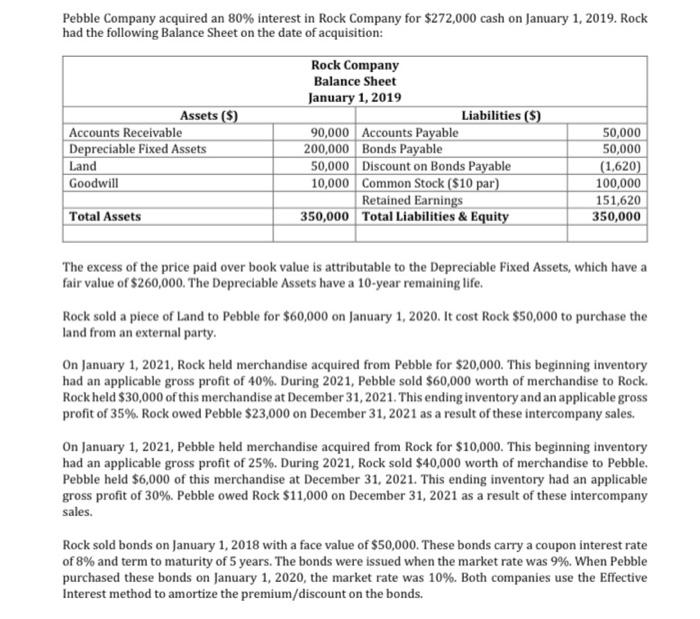Pebble Company acquired an 80% interest in Rock Company for $272,000 cash on January 1, 2019. Rock had the following Balance Sheet on the date of acquisition: The excess of the price paid over book value is attributable to the Depreciable Fixed Assets, which have a fair value of $260,000. The Depreciable Assets have a 10-year remaining life. Rock sold a piece of Land to Pebble for $60,000 on January 1, 2020. It cost Rock $50,000 to purchase the land from an external party. On January 1, 2021, Rock held merchandise acquired from Pebble for $20,000. This beginning inventory had an applicable gross profit of 40%. During 2021, Pebble sold $60,000 worth of merchandise to Rock. Rock held $30,000 of this merchandise at December 31,2021 . This ending inventory and an applicable gross profit of 35%. Rock owed Pebble $23,000 on December 31, 2021 as a result of these intercompany sales. On January 1, 2021, Pebble held merchandise acquired from Rock for $10,000. This beginning inventory had an applicable gross profit of 25%. During 2021 , Rock sold $40,000 worth of merchandise to Pebble. Pebble held $6,000 of this merchandise at December 31,2021 . This ending inventory had an applicable gross profit of 30%. Pebble owed Rock $11,000 on December 31,2021 as a result of these intercompany sales. Rock sold bonds on January 1, 2018 with a face value of $50,000. These bonds carry a coupon interest rate of 8% and term to maturity of 5 years. The bonds were issued when the market rate was 9%. When Pebble purchased these bonds on January 1,2020, the market rate was 10%. Both companies use the Effective Interest method to amortize the premium/discount on the bonds. Pebble and Rock had the following trial balances on December 31, 2021: Required: (1) Using TVM principles: a. Calculate how much Rock Company received on January 1: 2018 for issuance of the bonds. Round to the nearest dollar. b. Calculate how much Pebble Company paid to purchase the bonds on January 1" 2020. Round to the nearest dollar. c. Prepare one bond amortization schedule for both the issuer and purchaser. Round each figure to the nearest dollar. (2) Prepare the Eliminating and Adjusting Entries, the Schedules and Worksheet necessary to produce the consolidated financial statements of Pebble Company and its subsidiary for the year ended December 31,2021. Breakdown of Marks: Part (1) - 3 marks - Part (2) - 37 marks o Schedules - 17 marks Elimination \& Adjustment Entries - 121/2 marks - Columns (on worksheet) - 71/2 marks Pebble Company acquired an 80% interest in Rock Company for $272,000 cash on January 1, 2019. Rock had the following Balance Sheet on the date of acquisition: The excess of the price paid over book value is attributable to the Depreciable Fixed Assets, which have a fair value of $260,000. The Depreciable Assets have a 10-year remaining life. Rock sold a piece of Land to Pebble for $60,000 on January 1, 2020. It cost Rock $50,000 to purchase the land from an external party. On January 1, 2021, Rock held merchandise acquired from Pebble for $20,000. This beginning inventory had an applicable gross profit of 40%. During 2021, Pebble sold $60,000 worth of merchandise to Rock. Rock held $30,000 of this merchandise at December 31,2021 . This ending inventory and an applicable gross profit of 35%. Rock owed Pebble $23,000 on December 31, 2021 as a result of these intercompany sales. On January 1, 2021, Pebble held merchandise acquired from Rock for $10,000. This beginning inventory had an applicable gross profit of 25%. During 2021 , Rock sold $40,000 worth of merchandise to Pebble. Pebble held $6,000 of this merchandise at December 31,2021 . This ending inventory had an applicable gross profit of 30%. Pebble owed Rock $11,000 on December 31,2021 as a result of these intercompany sales. Rock sold bonds on January 1, 2018 with a face value of $50,000. These bonds carry a coupon interest rate of 8% and term to maturity of 5 years. The bonds were issued when the market rate was 9%. When Pebble purchased these bonds on January 1,2020, the market rate was 10%. Both companies use the Effective Interest method to amortize the premium/discount on the bonds. Pebble and Rock had the following trial balances on December 31, 2021: Required: (1) Using TVM principles: a. Calculate how much Rock Company received on January 1: 2018 for issuance of the bonds. Round to the nearest dollar. b. Calculate how much Pebble Company paid to purchase the bonds on January 1" 2020. Round to the nearest dollar. c. Prepare one bond amortization schedule for both the issuer and purchaser. Round each figure to the nearest dollar. (2) Prepare the Eliminating and Adjusting Entries, the Schedules and Worksheet necessary to produce the consolidated financial statements of Pebble Company and its subsidiary for the year ended December 31,2021. Breakdown of Marks: Part (1) - 3 marks - Part (2) - 37 marks o Schedules - 17 marks Elimination \& Adjustment Entries - 121/2 marks - Columns (on worksheet) - 71/2 marks








